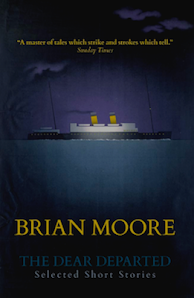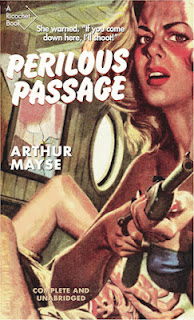Raymond Holmes [Raymond Souster]
Toronto: News Stand Library, 1949
160 pages
Anyone looking for a good story is sure to be disappointed. The plot is so thin, so unsurprising, so uninspired, that I have no hesitation in sharing it in full.
This shouldn't take long.
It is March 1945. Harry Byers, our hero and narrator, leaves Halifax for a war that everyone knows is all but over. Bournemouth, his destination, is the primary reception depot for RCAF personnel. Harry has barely set foot on English soil before being pressed by a new pal to go on a double date with WAAF gal Helen Noble. They hit it off and are engaged within days. Germany surrenders. Harry and Helen wed, honeymoon in Scotland, are separated due to respective service obligations, but are reunited in London. To borrow from F Scott Fitzgerald, Harry did "get over," but he never sees action.
Not that kind anyway.
And that's pretty much it.
What veteran, accustomed to regimentation and suddenly thrown on his own resources to take his place in the way of life for which he had fought, didn't experience a strange mixture of hope and despair, relief and nostalgia, determination and frustration, joy and bitterness, as did Harry in these two symbolic years?But can we really expect so much from so slim a volume?
It's best to approach The Winter of Time as a first novel that attempts much while adhering to strict confine enforced by the publisher's standard 160-page format. As evidence, look no further than the final three pages, in which Clair turns up unexpectedly in Toronto, announces that she's expecting, and becomes engaged to Harry. This rush of events, typical of News Stand Library endings suggests a writer who realizes the sudden need to wrap everything up. Souster proves himself superior to other NSL authors by applying the brakes with a closing descriptive paragraph that has Harry raising the blinds of his apartment "for no reason" and looking down on sunlight playing on once cloud-covered Sherbourne Street.
Three things make The Winter of Time worth reading, the first being the collision of life during wartime with the impetuous folly of youth. Harry and Helen decide to marry on their third date. The stuff of Las Vegas misadventure today, it was not so unusual at the time, particularly given the circumstances. My grandparents, who lived to celebrate their sixtieth wedding anniversary together, were one such couple. It has been claimed that service leads to maturity, but this is not the case with Harry. A married man in his mid-twenties, he cheats on his pregnant wife of one year with a woman he doesn't even like. Keep in mind, Harry is the narrator of this story.
There were a lot of girls checking their coats and purses. They had come stag, mostly in two's. They were the usual girls you saw at the Palais, girl who were now in the city and did not have a steady boy-friend. And most of them were nice kids, jus out for an evening of dancing.They were the prey of all the fast boys who thought they were God's gift to women. The fast boys were interested in only one thing, and every one had his own system of leading up to it, the only difference being that some were more subtle than others.
 |
| Palais Royale, Toronto, 1946 |
There are many more references to many more drinking establishments. I was most taken aback by mention of Montreal's Blue Bird Café, which a quarter-century later would be the site of one of the city's greatest tragedies.
As a child, I first read about it in the pages of the Montreal Gazette. It has haunted me ever since
Pete is a good guy and he has written some damn fine poetry. Poetry with guts that was still only grudgingly accepted in Canada. He had been very frankly critical about my work but mine was so close to the thing that he was tying to do himself that I knew he was honestly interested in it, and that was something very rarely found in another writer.This is the first indication that our hero holds literary aspirations. The second comes on the very same page when Harry describes his address book as being filled with names of publishers and old girlfriends. From this point on, references to thing literary are frequent; Joyce, Hemingway, Thomas Wolfe, and Morley Callaghan abound. Harry tells Pete he is impressed by his recent New York-themed verse, though just when and where he read it is a mystery. He is convinced his friend could be a great poet, the kind of poet Canada has needed for a long time, but never produced. As Harry tells Clair, "I'd hate to see his fine talent turned into something unnatural and a mockery after those university professor bastards and C.A.A. parasites got their claws into him."
"I think the whole writing game is a little overrated," I said. "Here in Canada, though, the odds are so much against any decent writer that he's practically buggered before he even starts. I guess we should all be college professors and join the C.A.A.""I'm seriously thinking of joining," Walter said, "All I've got to do is get rid of my artistic conscience and any pretensions of doing any more honest writing."
Is Pete Adams modelled on Ralph Gustafson? An even more interesting question is whether Jewish Montrealer Walter Green was inspired Ted Allan. Could be. Souster had to come to News Stand Library somehow. Allan's pseudonymous NSL pulp Love is a Long Shot was published two months before The Winter of Time. Garner, we know, came to NSL through Allan's recommendation. His Waste No Tears appeared eight months later under the name Jarvis Warwick.
The Winter of Time is not to be read for its plot, but it is to be read. It's a shame that it had to end so soon.
I wonder when Harry would've told Clair about his dead wife and newborn son.
The bottled beer came and we ordered two more pints. The beer was very good. I was just beginning to appreciate it. You could tell it was Montreal beer. The best beer.On drinking in New York:
The beer was very amber and clear, lighter than Canadian beer. It was milder and pleasanter to drink, I thought, than our beer if you were only interested in a cool drink and did not want to feel happy after two or three glasses.A query: Are we really meant to believe that the Sunday Times received an advance review copy of a Canadian pulp novel?
Object and Access: A typical News Stand Library book, except that it has fewer mistakes than most. I caught one sentence that cuts off after the first word. Clair appears variously as "Claire" and "Clare."Buses is misspelled "busses," but that's a common error.
Well done!
D Rickard's cover is strange, even by News Stand Library standards. At no point in the novel does our hero walk down Bloor Street. Neither of the two girls he knows in Toronto has black hair. And doesn't that gal look an awful lot like Rickard's rendition of Gisele Lepine from Sugar-Puss on Dorchester Street (1949). And aren't their dresses very similar?
As of this writing, just one copy is listed for sale online. Price: US$195.00.
I received my copy as a gift last Christmas.


















































